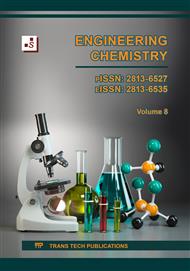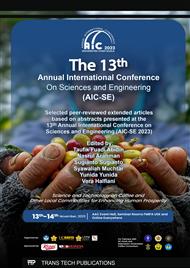[1]
H. Hassan, A. Salama, A.K. El-ziaty, and M. El-Sakhawy, "New chitosan/silica/zinc oxide nanocomposite as adsorbent for dye removal," Int. J. Biol. Macromol., vol. 131, pp.520-526, 2019.
DOI: 10.1016/j.ijbiomac.2019.03.087
Google Scholar
[2]
Y. Chen, X. Gong, G. Yang, Q. Li, and N. Zhou, "Preparation and characterization of a nanolignin phenol formaldehyde resin by replacing phenol partially with lignin nanoparticles," RSC Adv., vol. 9, no. 50, p.29255–29262, 2019.
DOI: 10.1039/c9ra04827h
Google Scholar
[3]
F. Rafiee and F. Rezaie Karder, "Bio-crosslinking of chitosan with oxidized starch, its functionalization with amino acid and magnetization: As a green magnetic support for silver immobilization and its catalytic activity investigation," Int. J. Biol. Macromol., vol. 146, no. xxxx, pp.1124-1132, 2020.
DOI: 10.1016/j.ijbiomac.2019.09.238
Google Scholar
[4]
P.K. Panda, J.M. Yang, Y.H. Chang, and W.W. Su, "Modification of different molecular weights of chitosan by p-Coumaric acid: Preparation, characterization and effect of molecular weight on its water solubility and antioxidant property," Int. J. Biol. Macromol., vol. 136, p.661–667, 2019.
DOI: 10.1016/j.ijbiomac.2019.06.082
Google Scholar
[5]
S. Sabar et al., "Preparation of sulfonated chitosan for enhanced adsorption of methylene blue from aqueous solution," React. Funct. Polym., vol. 151, no. March, p.104584, 2020.
DOI: 10.1016/j.reactfunctpolym.2020.104584
Google Scholar
[6]
Q.J. Chen, L.L. Zhou, J.Q. Zou, and X. Gao, "The preparation and characterization of nanocomposite film reinforced by modified cellulose nanocrystals," Int. J. Biol. Macromol., vol. 132, p.1155–1162, 2019.
DOI: 10.1016/j.ijbiomac.2019.04.063
Google Scholar
[7]
L. Shao et al., "Immobilized and photocatalytic performances of PDMS-SiO 2 -chitosan@TiO 2 composites on pumice under simulated sunlight irradiation," Appl. Surf. Sci., vol. 478, no. January, p.1017–1026, 2019.
DOI: 10.1016/j.apsusc.2019.02.060
Google Scholar
[8]
A. ZabihiSahebi, S. Koushkbaghi, M. Pishnamazi, A. Askari, R. Khosravi, and M. Irani, "Synthesis of cellulose acetate/chitosan/SWCNT/Fe3O4/TiO2 composite nanofibers for the removal of Cr(VI), As(V), Methylene blue and Congo red from aqueous solutions," Int. J. Biol. Macromol., vol. 140, p.1296–1304, 2019.
DOI: 10.1016/j.ijbiomac.2019.08.214
Google Scholar
[9]
A. Gozdecka and A. E. Wiącek, "Effect of UV radiation and chitosan coating on the adsorption-photocatalytic activity of TiO2 particles," Mater. Sci. Eng. C, vol. 93, no. July, p.582–594, 2018.
DOI: 10.1016/j.msec.2018.08.022
Google Scholar
[10]
H. Fathana, "Modification of Chitosan Using Glycidyl Methacrylate-grafted Cellulose (GMAgCell/Chi) for Methylene Blue Adsorption Modification of Chitosan Using Glycidyl Methacrylate-grafted Cellulose (GMAgCell/Chi) for Methylene Blue Adsorption."
DOI: 10.33640/2405-609x.3322
Google Scholar
[11]
W. Zhang, N. Grimi, M. Y. Jaffrin, L. Ding, B. Tang, and Z. Zhang, "Optimization of RDM-UF for alfalfa wastewater treatment using RSM," Environ. Sci. Pollut. Res., vol. 25, no. 2, p.1439–1447, 2018.
DOI: 10.1007/s11356-017-0588-8
Google Scholar
[12]
Z.M. Khoshhesab, Z. Ayazi, and M. Dargahi, "Synthesis of magnetic graphene oxide nanocomposite for adsorption removal of reactive red 195: Modelling and optimizing via central composite design," Int. J. Nanosci. Nanotechnol., vol. 16, no. 1, p.35–48, 2020.
Google Scholar
[13]
A. Pardo et al., "Self-regenerating photocatalytic hydrogel for the adsorption and decomposition of methylene blue and antibiotics in water," Environ. Technol. Innov., vol. 11, pp.321-327, 2018.
DOI: 10.1016/j.eti.2018.06.005
Google Scholar



